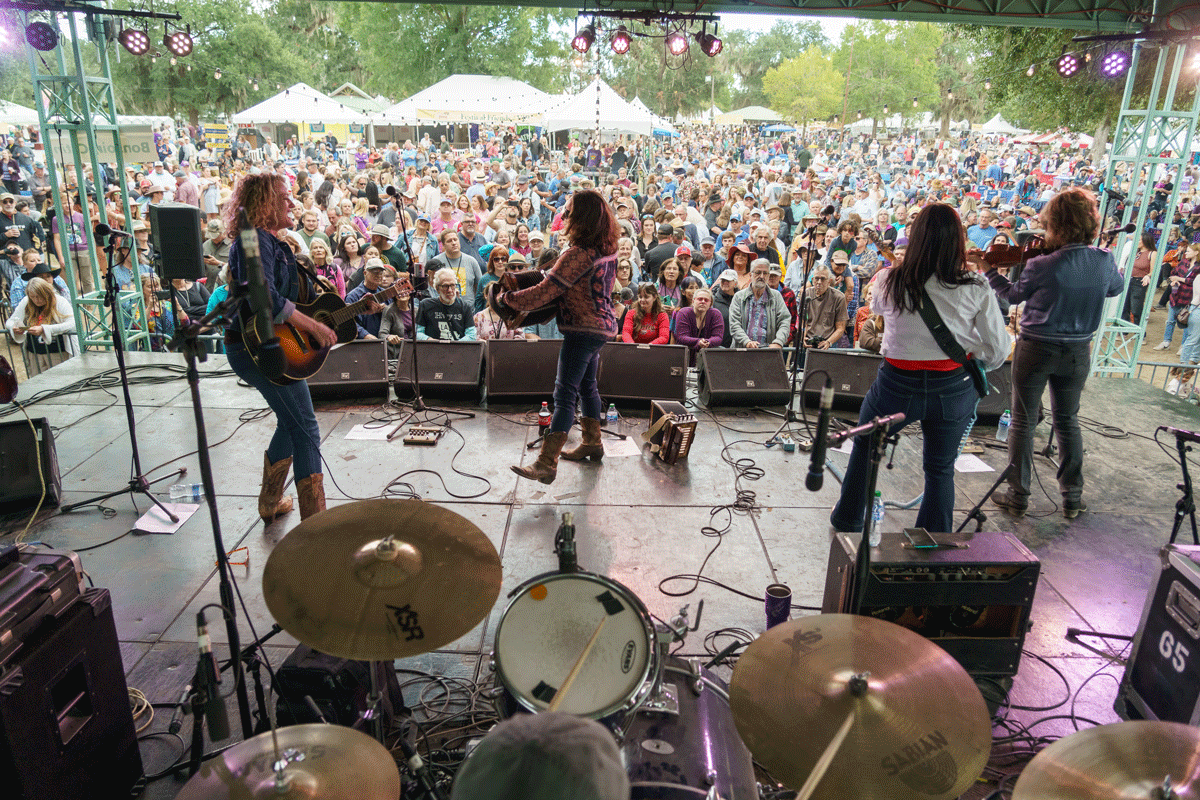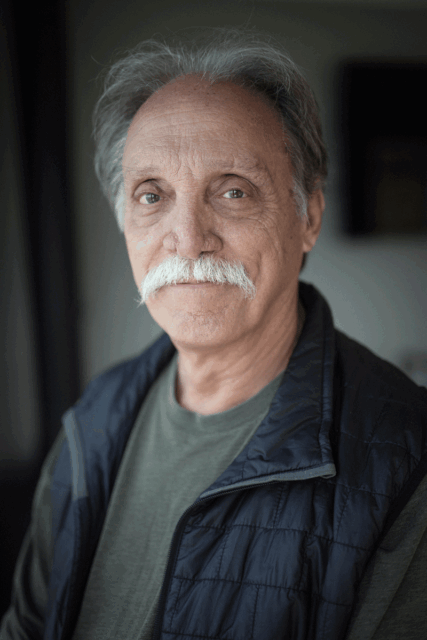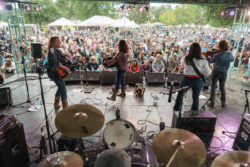Summer 2025
Celebrating Louisiana’s Cajun and Creole Cultures
Festivals Acadiens et Créoles is the 2025 Champion of Culture
Published: May 30, 2025
Last Updated: May 30, 2025

Courtesy of Festivals Acadiens et Créoles
Bonsoir, Catin performing at Festivals Acadiens et Créoles in 2023.
What eventually evolved to become Festivals Acadiens et Créoles in Lafayette, held each fall in Girard Park, was born as an evening concert on March 26, 1974, in Blackham Coliseum. James Domengeaux, Chairman of the Council for the Development of French in Louisiana (CODOFIL), was hoping to form a public gathering to build grassroots momentum for the budding Louisiana French revitalization movement. A program devoted to Cajun and Creole music would serve as a show of support for the state’s indigenous French culture.
Cajun musician Dewey Balfa suggested a concert format. Inspired by his experience at the Newport Folk Festival in the 1960s, where he performed for the first time before a seated audience that applauded in response to his music instead of his usual dancehall crowd, he felt that a concert would help people listen to the music in a different way, while also providing an opportunity to present historical and cultural commentary. I had finished my coursework at the University of Southwestern Louisiana (today University of Louisiana at Lafayette) and was working as an aide at CODOFIL while waiting to graduate in May. Keith Cravey was a student at the university with a side job at La Louisianne Records and a bit of experience in theatre and music production. His boss at the record company sent him to help organize the concert.
To plan and produce the event, we worked with CODOFIL staffers, a cultural advisory committee composed of musicians and community leaders, and Ralph Rinzler, a musician and musicologist who had done fieldwork for the Newport festival and became director of folklife programs at the Smithsonian Institution. The first Tribute to Cajun Music concert was a huge success, surpassing even our own wildly optimistic hopes. A thunderstorm flooded Lafayette’s streets that afternoon, but well over eight thousand people flooded Lafayette’s Blackham Coliseum that evening to celebrate our own music. People of all ages were in attendance—members of the older generation, as well as their children, along with a surprising number of teens and young adults. It was a time across the nation and the world when social awareness was vibrant, and our counterculture movement involved looking inward and reassessing the value of our own heritage.

Cajun folklorist and ethnomusicologist Barry Jean Ancelet was one of the original founders of Festivals Acadiens et Créoles. Photo by Nicole Boudreau
A year later, in April 1975, CODOFIL followed up with a second Tribute to Cajun Music concert. Keith Cravey produced that show on his own while I was attending graduate school in Indiana. In October 1976, Keith and I were back together to produce a third concert, but this time we moved it outdoors to Girard Park and joined forces with the Louisiana Native Crafts Festival. In September 1977, the Lafayette Convention and Visitors Commission joined the cooperative effort, adding their Bayou Food Festival. The combination of these three events focusing on the crafts, music, and food of South Louisiana was the basis for what came to be called Festivals Acadiens.
In 1980, CODOFIL handed off the sponsorship of the festivals to the Lafayette Jaycees community organization. That same year, in addition to the main stage for performers and tents for concessions, the festivals also began to develop a workshop stage featuring discussions and demonstrations of Louisiana French cultural heritage under the direction of Pat Mould, a renowned local chef who was also a Cajun music and zydeco fan. This innovation led to the development of the Heritage Stage, which eventually evolved into a second performance stage with its own crew. An enhanced Atelier Stage continued to provide workshop demonstrations and small group performances. A few years later, the Dancehall Tent was added.
In 2007, production team members formed a community board and established an independent nonprofit corporation to stabilize the event’s financial foundations. Board members also officially changed the name to Festivals Acadiens et Créoles to more accurately reflect the cultures that have always been the focus of all components. Keith eventually moved on; I remain in harness to this day, along with board members Pat Mould, André Mitchell, Linzee Lagrange, Helena Putnam, and Louis Ancelet, and countless volunteers over the years.
Since their foundation in the early 1970s, the crafts, food, and music festivals now known as Festivals Acadiens et Créoles have consistently championed creative cultural continuity. Organizers strive to present the current state of the culture through performances that can range from thoughtful preservation to daring innovation, from the oldest ballads to the latest in experimental Cajun music and zydeco, from traditional gumbos to crawfish eggrolls, from historical wooden boats to innovative multimedia folk art. And the musicians, cooks, and craftspeople who participate in this annual event continue to invest themselves in what most rightly consider their own festival, a personal and community-wide celebration of Cajun and Creole culture.
Our counterculture movement involved looking inward and reassessing the value of our own heritage.
One of our goals has always been to preserve our cultural heritage. Another goal is to encourage the transmission of this heritage to subsequent generations. Attracting aspiring young musicians by drawing their attention to the stage was part of the deliberate process of nurturing the traditions. But audience interest and engagement are less predictable and harder to manage than the production elements of a high-quality concert. We learned many years ago that no one can force anyone, especially young people, to do much of anything. All we could do was make these musical lineages attractive and available. Judging from the average age of the crowds pressing the front of the stages, especially during the inevitable “moments” each year when it is obvious that something special is happening—when the process is shifting into a higher gear, when performers are clearly striding confidently into the future—this effort too seems to be working.
Probably because these moments are connected to history and innovating the future all at once. It sounds familiar and it rocks. Riding the wave of popular culture may be tenuous, but without that, Cajun and Creole music would soon be relegated to preservation halls and museums, a sure sign of their imminent demise. Instead, they are being played at festivals and jam sessions and bars and house parties and lots of other events, locally and around the world.
The steady surge of creative energy and excellent musicianship by artists of all ages within the Cajun music and zydeco communities is impressive. New musicians and new takes on the music emerge as the traditions continue to thrive and evolve on their own terms—as folklorist Henry Glassie put it, “using the past to create the future.”
If someone had told me in 1974 that, fifty years later, we would be having a hard time cramming top-tier bands into the forty time slots we now have available on three full-blown stages, I would have thought, “Yeah, in my wildest dreams.”
Here we are, in my wildest dreams.
Barry Jean Ancelet is Professor Emeritus of Francophone Studies and Center for Louisiana Studies Research Fellow at the University of Louisiana at Lafayette. He has given many papers and published numerous articles and several books on various aspects of Louisiana’s Cajun and Creole cultures and languages, and was a co-founder of Festivals Acadiens et Créoles.
